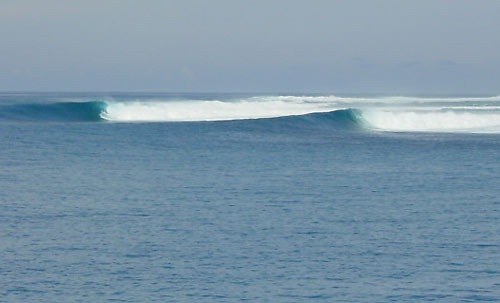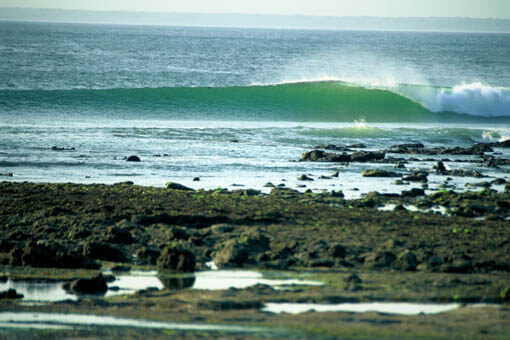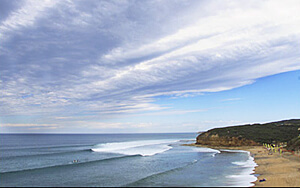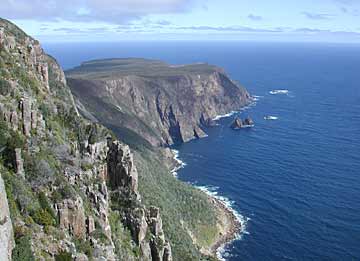The greatest island in the world, with its reef surfing in the tropics to a surf travel trip in the deep south and its cold water big wave surfing. Australia offers it all for a great surf trip. Friendly people that enjoy one of the best living conditions this planet has to offer. There are great waves and surf the whole of its 59,736km coast line. A lot made up by the thousands of small fringing islands and numerous larger ones.
Is a surfers paradise. It's a country of so many cultures and different landscapes. It's the worlds largest island and has one of the worlds largest desert with the worlds largest rock. European culture dominates but Asia is on its doorstep and more and more these two cultures are influencing eachother in a unique way. Australians have always been avid travellers and many Australians feel comfortable in the Asian countries to their north.BUT!,
(aerial shot) TWEED/ COOLANGATTA

A LAND OF CONTRAST

serious sun protection needed

A taste of some of the many australian surfing spots it has on offer.
Sunshine coast and Gold coast. cyclone season starts in november and runs through to april, on average 2 or 3 cyclone swells a year. Low pressure systems usually start up in the coral sea and head south, generating epic waves on all the points such as noosa heads, burleigh heads,kirra point.
If the swell is huge it's best to head for Noosa Heads where its headlands at Granite, Teatree and Nationals offer protection from the accompanying winds. Teatree is a classic queensland point break with jacking takeoffs, barrels and long walls in a magic surf trip type setting.
The most consistent surf is found from february to july, but it can get good at anytime.The usual wave height is 2 to 6 foot. Cyclone swells can reach up to 15 foot plus making noosa the only choice. Though with the "tow ins" getting more popular, the points whose fierce rips kept surfers out over 10feet are now getting surfed. Crowd factor on the points in good surf is full on but the numerous beach breaks can be almost empty. Queensland offers classic point breaks, in the Coolangatta area you'll find Kirra, Schnapper Rocks, Greenmount. A little further north is Currumbin and Burleigh Heads. Surfers the world over love this stretch of coast, not only for the quality of the breaks but also for its hinterland and nightlife. The Sunshine coast to the north, about 2-3 hours drive passing through Brisbane has a reputation for a more layed back attitude, The point breaks aren't as numerous but are just as classy. Noosa Heads is a must see and if you score it when it's on you'd be hard to find anything better anywhere.Further noth there is litle consisitent sewll as the Great Barrier reef protects the coast line from heavy swell.
First stop is duranbah on the far north coast at the border of Queensland. It's one of the most consistent surf spots on the east coast. It's a Very powerful jacking wave depending on its sand banks at the time, with numerous surf breaks in its stretch of beach.
Lennox Head:
A powerful right hand wave, holds up to 12 foot easily. Getting out and back in, can be a bit of a mission, but well worth the danger.
Treachery head:
Perfect in a north easter, also picks up a lot of swell.Head to Seals rocks on the mid north coast.
Sydney
The foreshore is over 250km of sandy beaches, idyllic harbours, protected coves, thundering surf and awesome cliffs at Watsons Bay.
The Maroubra toilet bowl:
a powerful right that throws square on south to southeast swells.one of the numerous breaks in the Sydney region.
Blue rocks:
Head to NSW south coast south of the Tomago river. Blue Rocks is a heavy take off into a big bowly section.

Torquay, surf city, home to Bells,winkipop,centreside,and thirteenth. All classic waves.
Port Campbell:
Some of the most powerful and largest rideable waves out side of Hawaii. Cold water power and awe inspiring views.

BELLS BEACH
Daley Heads; an unreal left that will make you feel like you are in Mexico.It's found among the many good waves on the Yorke Peninsula.
CACTUS-Turn off at Penong on the nullabor hwy. 21km later and you're at one of Australias legendary surf spots.Caves, Castles, Cactus, Cunns, Backdoors and Witzigs. Watch out for white pointers though, they too enjoy this place and there have been fatal attacks here.
With 12,500 kilometres of coastline, it is no wonder that surfing in Western Australia is a major attraction for tourists as well as locals.
In the south, the year-round surf can rise to three to four metres and the power of these waves is comparable to the waves found in Hawaii.
Margaret river area has so many powerful breaks. Friendly crew and not too crowded. Head north surfing places like Yallingup and all the other"ups" until you get to Mandurah.
Skip Perth and head north to Geraldton, then right up through to the bluff.
W.A. has a lot of power so be prepared. The travel north can be a dry lonely trip but the rewards are great.
Northern Western Australia boasts more seasonal surf, with places like Red Bluff and Gnaraloo Bay near Carnarvon as two of the most sought-after spots.
Around this area, the desert meets the coast where the ocean wash up against unique rock formations.
Here the best wave surfing months are May to August and many world-class surfers can be seen 'getting tubed' through the well-formed hollow waves.
A lot of stuff recently has been written about Tasmanian Surf. Mainly through the exposure of the surf press, they can't help themselves. It's what they do. The main talk has been about Shipstern Bluff, two hours' hike or a boat ride around the Tasman National Park in the state's south-east. It's also called Fluffy's because it's anything but.
Shipstern is a granite rock reef set only a few metres off the spectacular Tassie Peninsular. Huge Southern Ocean swells hit the reef head-on.
Creating a mean and nasty pitching wave.

Not for the inexperienced, enjoy the walk out.
Tassie has plenty of uncrowded breaks with clean, powerful walls, you’ll get a buzz out of Tassie surfing.
Close to Hobart, Park and Clifton Beaches are the favourite spots. Eaglehawk Neck on the Tasman Peninsula usually has a wave, and all up the East Coast from Orford to Bicheno there’ll be somewhere breaking. Further south, Bruny Island’s Cloudy Bay faces the wide Southern Ocean - it gets really big. So does South Cape Bay - surfers carry their boards on a 7 kilometre bushwalk through the World Heritage Area to reach this South Coast beach.
Along the north coast, Bass Strait generates waves at a string of good beaches - try Tam O’Shanter north-east of Launceston or the gnarly Mersey Mouth at Devonport. In the west, Marrawah’s big Southern Ocean groundswells challenge the best.
Bring your wetsuit - like anywhere else in southern Australia, you’ll need it.